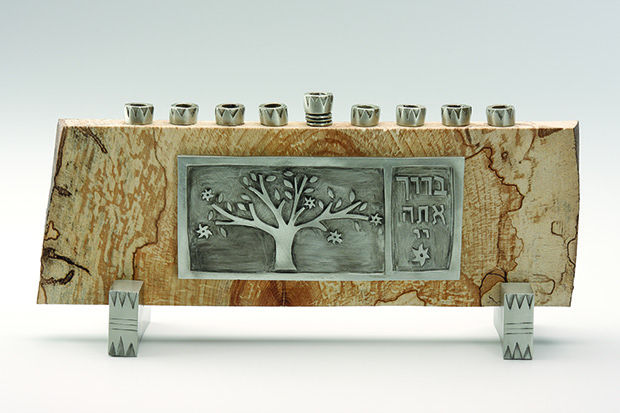Designer’s passion is reflected in her jewelry, Judaica
Published April 23, 2015
For jewelry and Judaica designer Emily Rosenfeld, the enjoyment her customers find in her work is just as important to her as the work itself.
“I love making beautiful objects for people to celebrate with,” she said.
Originally from St. Louis, Rosenfeld lives in Florence, Massachusetts. She has created jewelry for the past 23 years and Judaica for 19. She designs her pieces, has them cast in New York and Rhode Island, then does all the assembling and finishing.
In St. Louis, Rosenfeld’s work can be found in the Gallery Shop at the Craft Alliance Center of Art + Design, 6640 Delmar Boulevard in the Loop.
Examples of her sterling and pewter jewelry include hamsa-shape earrings, charm bracelets and personalized necklaces.
Rosenfeld, 51, has a writing background but discovered her passion for design in college when she worked for a jewelry designer in upstate New York.
“The lifestyle was appealing to me,” she said. “I liked the idea of interacting with customers and making a living through art.”
With regard to Rosenfeld’s Judaica, her pieces include mezuzot, Shabbat candlesticks, Kiddush cups, yads and menorahs.
“I give these traditional objects a contemporary feeling,” she said.
Rosenfeld selects Jewish symbols such as pomegranates and hamsas and depicts them in her unique fashion, with clean lines and stylized forms.
Mezuzot hold special meaning for Rosenfeld.
“People adorn their homes with them,” she said. “They’re accessible. People feel good giving them and receiving them. Parents buy them for their children’s first houses. There are lots of rituals surrounding the home.
“My mezuzot can go inside or outside the house. They’re durable and aren’t affected by weather.”
Her mezuzot range from simpler ones, with curving lines and a streamlined shin, to more complex pieces. One displays animals from Noah’s Ark; another takes the shape of a bird with folded wings, reaching up with its beak to touch the shin.
“Another piece I design is called a Miriam’s Cup,” Rosenfeld said.
This is a new ritual object used in the seder. Filled with water, the cup represents the miraculous well Miriam found in the desert after the Exodus.
“These cups bring Miriam into a more prominent place in the seder and Passover story,” Rosenfeld said. “They’re also a powerful gift to give a girl.”
She came to offer Miriam’s Cups in her design line by way of a customer’s request.
“I try to listen to what customers want,” she said. “If someone asks for something, I try to make it.”
Rosenfeld highly values her customers’ input and the way they relate to her pieces.
“I want customers to feel like my jewelry has meaning, that it reflects their religious or spiritual beliefs. My pieces convey a sense of joy. They help people celebrate what’s important to them.”
Affordability is also a necessary factor in Rosenfeld’s work, and guides her choice of materials.
“Pewter lends itself to affordability,” she said. “It’s a soft metal, it flows well into molds and is easy to cast. I love its heaviness and color. And my jewelry is predominantly sterling, which is beautiful and affordable.”
In addition to the use of metals in her Judaica, Rosenfeld incorporates spalted maple, wood harvested from fallen maple trees. The wood of these trees features unusual patterns.
“It’s challenging to run a small business and have a family in this economy, but it’s also rewarding making a living in this creative way,” she said. “I’m grateful for it.”
For more information about Rosenfeld’s work, visit emilyrosenfeld.com.















